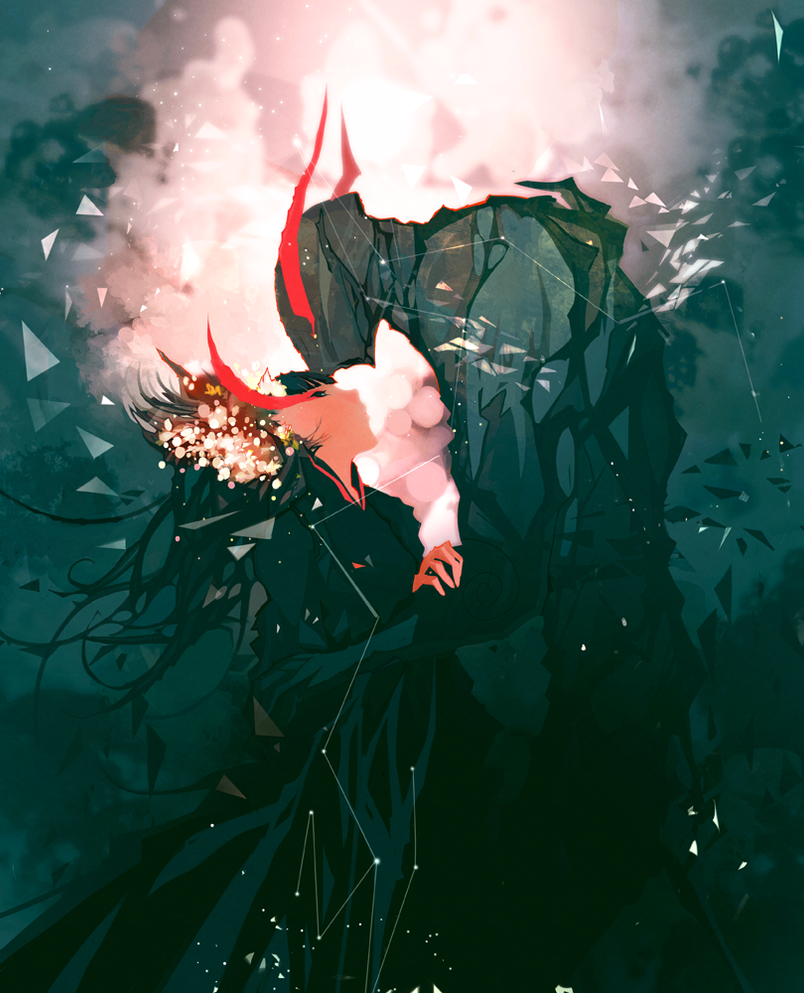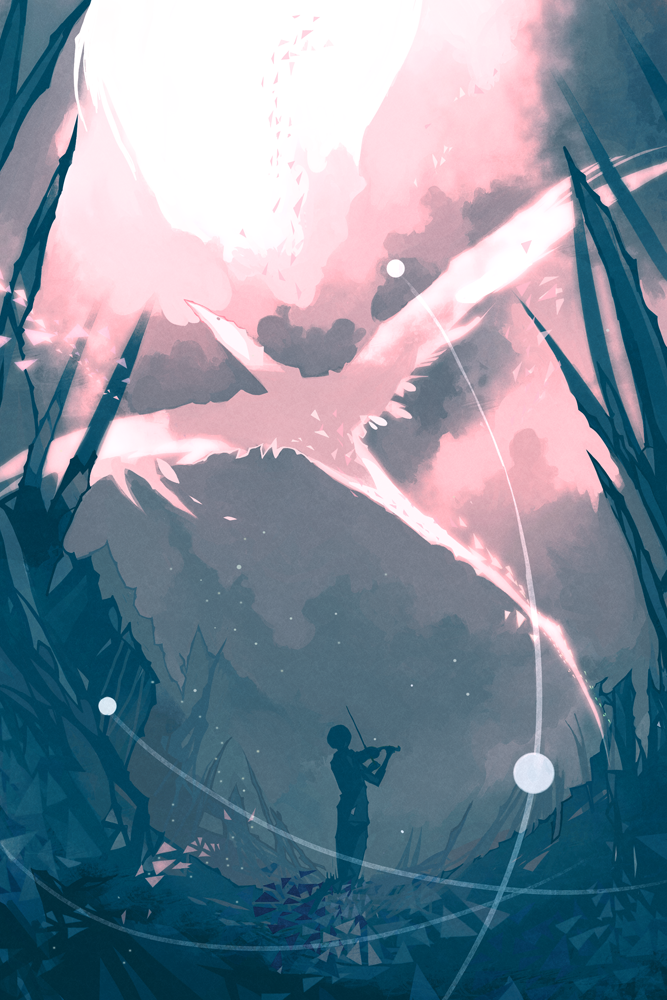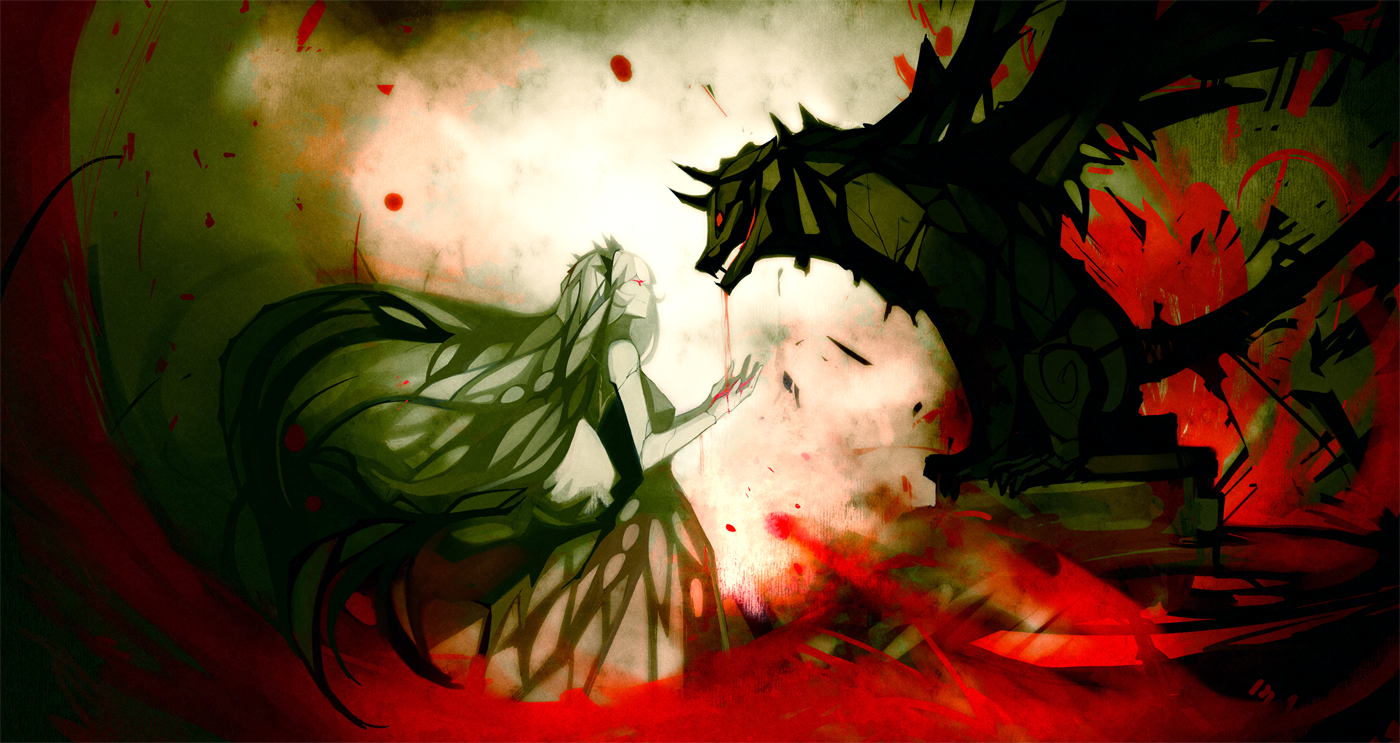Umbra Regalia
There's no place like 127.0.0.1

What differentiates Weavers from the standard military soldier is the weapons they use and how they use them. Very similar to Reapers, Weavers have a Core lodged into the center of the chests that allow them to use what are called Threads. Though, Weavers use Threads entirely different to those used by the Reapers. They come in many types, most imitating the elements that create the world. Threads can take two molecular forms; solid and liquid. It has not yet been discovered how to turn them into a gaseous state. Though, there are two exceptions to this rule, being Light and Shadow Threads. These two can reach Plasma state, though they skip gaseous state altogether.
Threads can create almost anything, with the exception of anything sentient. Anything formed with solid Threads most often appears to have the texture of carbon fibre, yet there are some Threads that do not follow this example.
The liquid state of Threads allows easier fusing of Threads, leaving the liquid form to be the most useful for larger scale building. Though, it is recommended to solidify the Threads once the shape is complete as liquid Threads are often quite fragile.
Threads, as mentioned before, come in many shapes and sizes. These are those currently available for Weavers:
- Fire Threads - In appearance they resemble red hot metal, yet at a closer glance they appear to be molten lava. These Threads are of an average thickness but can easily be stuck together to create a thicker look. They are extremely hot to the touch, ranging from 300 degrees Fahrenheit up to a maximum of 2000 degrees Fahrenheit. Though, the average Fire Weaver can only reach a temperature of 1300 degrees Fahrenheit. (Hint: Gold melts at 1947 degrees) Fire Weavers often experience high body heat due to the inactive Threads the Core places within their bodies (average Fire Weaver body temperature is 107.9 degrees Fahrenheit, average human body temperature is 98.6 degrees Fahrenheit.)
- Water Threads - In their liquid state, they strongly resemble natural clear water that would be contained within a very small tube (of course, without the tube). In it's solid state it looks like a thin piece of frost. These Threads are often very thin and extremely fragile, yet they can build tremendous force in liquid form when in large quantities. These Threads can reach temperatures as cold as -50 degrees Fahrenheit.
- Earth Threads - These Threads do not have a liquid form and instead have two appearances. When hardened, they resemble stone more than when they are weakened, which looks more like dirt. When hardened they have the same strength as granite. These Threads contain characteristics of many minerals including quartz sandstone, calcite, talc, and more types that are often found in the earth's crust. They are often room temperature (approx. 70 degrees Fahrenheit) but can become body temperature with enough coaxing. Otherwise, their temperature largely remains the same.
- Metal Threads - The strongest type of Threads, these strongly resemble carbon fibre in it's texture. The Threads are largely formed of copper, platinum, titanium, lead, carbon and more natural metals. Metal Weavers are also capable of concentrating the Threads into having more magnesium traits, giving it the ability to give off extremely bright light when set alight. These metals are often room temperature without outside influences (ex. Flames, Fire Threads, etc.).
- Gemstone Threads - These Threads largely consist of traits from gemstones such as sardonyx, garnet, diamond, beryl, spinel, topaz, etc. They are extremely hard to coax into liquid state, only highly experienced Weavers being able to do so due to the strength of the materials. Depending on the traits most prominent in the Threads at the given time, they can show various levels of strength or fragility. These Threads are often room temperature or lower, but often don't go below the temperature of -10 degrees Fahrenheit.
- Glass Threads - The most fragile of the Threads yet one of the easiest to master. These Threads are most often clear and colorless but can be mixed with dyes or metallic salts to create a stained glass appearance. Glass Threads are known to reach temperatures as high as 1600 degrees Fahrenheit, though this temperature forces it into it's liquid state. These Threads, unlike the Fire Threads, do not affect the host's body temperature in any way.
- Shadow Threads - One of the two most rare Threads. These are extremely rare due to the low survival rate in Weavers who opt to receive this type of Core; only 30% of applicants making it out of surgery. This Thread type has extremely unique traits, the default molecular state being a plasma-like form causing these Threads to be one of the most difficult to control. When concentrated into a solid state they resemble strongly a dark fractal formation. Yet, when very strongly condensed they are almost completely opaque. In their liquid form they resemble darkened water most often, and just as with their solid state they can be condensed to become more opaque. Though, when in their plasma-esque state they are very similar to a black cloud, though it is strongly recommended not to use this form often as they are very unstable at that point. These are one of the fastest Threads currently available, yet are currently still only within Project status. These Threads comfortably sit at a temperature of 38 degrees Fahrenheit, just above the temperature at which water begins to freeze. This causes the average Shadow Weaver's body temperature to be around 74.5 degrees Fahrenheit. These Threads are known to displace matter, causing blades made of these Threads to be extremely sharp and deadly, though due to the almost weightless nature a weight is required to form weapons efficiently.
- Light Threads - The brighter counterpart of Shadow Threads. These Threads are extremely similar to Shadow Threads in the sense of appearance, though they are of the complete opposite hue. Having a white-golden fractal-like appearance in their solid state and their liquid state being quite similar to a watery look yet with a subtle golden hue. Though, this golden hue can be changed depending on what the Threads touch. For example, if bounced off of Gemstone Threads, they may emit many colorful rays. These Threads are most often at a temperature of 230 degrees Fahrenheit, causing a Light Weaver's body to often be around 100 degrees Fahrenheit. These Threads have about the same weight as Shadow Threads, thus they are recommended to be used alongside a weight if being used as a physical weapon such as swords or bullets.

Projects:
Projects are something Weave has recently become more open about, revealing the identities of past Projects and opening the possibility of requesting to become a Project of their own. (Ask a GM before indicating your character will be a Project. This way, we can help you plan out what this Project will be and how it will work.)
Projects are created in order to test out new types of Threads or Thread forms. Some examples are Project Artemis, this Project being an attempt to mix both Light and Shadow Threads together. Regrettably, Project Artemis was a complete fail and was dropped. The most famous is Project Reaper, the original attempt to create Shadow Threads. This Project was deemed a complete failure and was retried under the name of Project Grim Reaper. Project Sentinel was the Project to create Light Threads and came with more ease than it's counterpart Project Reaper. Another notable Project was Project Pluto, the attempt to create a non-human soldier similar to the Reapers. This Project was also a failure, yet they are still attempting to fix their mistakes.
Cores come in every type that the Reapers do, as they are strongly modeled after those of the Reapers. Most Weavers receive a Grunt Core at first, though there are some very rare cases of Weavers beginning with an Elite Core.
If two Thread types are to mix within a single host, said host is most likely to die almost immediately (given there be enough Threads of both types.) This is most common between Light and Shadow Threads, as they tend to fight over space. When connected, they gain an acidic trait and can easily burn through most materials. This is also true inside a body, thus if a Light Thread were to enter a Shadow Weaver's body (or vice versa) the inactive Threads inside the body would become active and fight with the intruding Threads effectively burning the host acidicaly from the inside and causing excruciatingly painful death for the host.
Also, while Threads do not contain nerves like limbs do, they still feel similar to extra limbs. This is a psychological effect, so if a Weaver were to see his/her Threads break it would feel like tearing muscle. The level of pain depends on how many Threads were severed.
On the main base, there are barracks offered for those who have been transferred and/or have no alternative housing options. These barracks are shared between the genders, and there is a different room for each squad so that Weavers will stay with the other members of their squads who have opted to live in the barracks. Though, barracks are not forced on the Weavers so if they have an alternative housing option they are able to live there. Many Squad Leaders choose to live outside of the base while other members of squads do not due to the pay of the average Weaver being just high enough to afford a small, run down apartment.
Weavers are also free to roam the city, though Squad Leaders are asked to stay within the base's walls for at least four hours a day during weekdays. Otherwise, they are also free to leave the base.
If you have any questions about Weavers, Cores and Threads (we know it's a little complicated) don't hesitate to ask them in the Question forum of the roleplay. If you're uncomfortable with posting it publicly, we're open to PM questions too! It's better to ask a thousand questions than to attempt to understand it on your own and mess up while roleplaying.

Last edited by a moderator:

